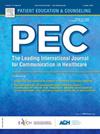Co-creating a Choosing Wisely leaflet supporting the reduction of imaging usage in low back pain management – A multi-method study
IF 2.9
2区 医学
Q2 PUBLIC, ENVIRONMENTAL & OCCUPATIONAL HEALTH
引用次数: 0
Abstract
Objective
The objective was to co-create an information resource in the form of a leaflet, to be distributed in clinical settings, websites or social media targeting people with low back pain.
Methods
This multi-method study was conducted in four stages: literature search, input from practice consultants, program theory development, and think-aloud interviews with people experiencing low back pain. Each stage was followed by a consensus meeting in which the steering group refined the leaflet based on the emerging knowledge.
Results
The literature search highlighted patients' need for easy-to-understand information about their back pain diagnosis, management strategies, social activities, work and solutions for supported self-management strategies. Practice consultants emphasized concise, relatable content. The program theory identified potential mechanisms for content creation, development, and implementation of the leaflet, such as addressing patient concerns, reducing diagnostic uncertainty, insights into management options, and validation. Think-aloud interviews with 18 people living with low back pain informed the iteration of the leaflet, enhancing language clarification and content comprehension.
Conclusions
We co-created a new Choosing Wisely leaflet, created with end-users in mind, specifically focused on reducing unnecessary imaging for low back pain.
Practice implications
This leaflet may support clinical settings in delivering evidence-based approaches and supporting self-management.
共同制作一份支持减少腰痛管理中影像学使用的明智选择传单-一项多方法研究
目的以传单的形式共同创建一个信息资源,在临床环境、网站或社交媒体上分发,目标是腰痛患者。方法本研究分四个阶段进行:文献检索、实践咨询、程序理论开发和对腰痛患者的思考访谈。每个阶段之后都有一个共识会议,指导小组根据新出现的知识改进传单。结果通过文献检索,患者对背痛诊断、管理策略、社会活动、工作以及自我管理策略的解决方案等方面的信息的需求较为简单易懂。执业顾问强调简洁、相关的内容。程序理论确定了传单内容创建、发展和实施的潜在机制,如解决患者关注的问题、减少诊断的不确定性、对管理选择的见解和验证。通过对18名腰痛患者的访谈,我们了解了传单的内容,提高了语言的清晰度和内容的理解力。我们共同制作了一份新的“明智选择”传单,以最终用户为中心,特别关注减少对腰痛的不必要成像。实践意义本手册可能支持临床设置提供循证方法和支持自我管理。
本文章由计算机程序翻译,如有差异,请以英文原文为准。
求助全文
约1分钟内获得全文
求助全文
来源期刊

Patient Education and Counseling
医学-公共卫生、环境卫生与职业卫生
CiteScore
5.60
自引率
11.40%
发文量
384
审稿时长
46 days
期刊介绍:
Patient Education and Counseling is an interdisciplinary, international journal for patient education and health promotion researchers, managers and clinicians. The journal seeks to explore and elucidate the educational, counseling and communication models in health care. Its aim is to provide a forum for fundamental as well as applied research, and to promote the study of organizational issues involved with the delivery of patient education, counseling, health promotion services and training models in improving communication between providers and patients.
 求助内容:
求助内容: 应助结果提醒方式:
应助结果提醒方式:


